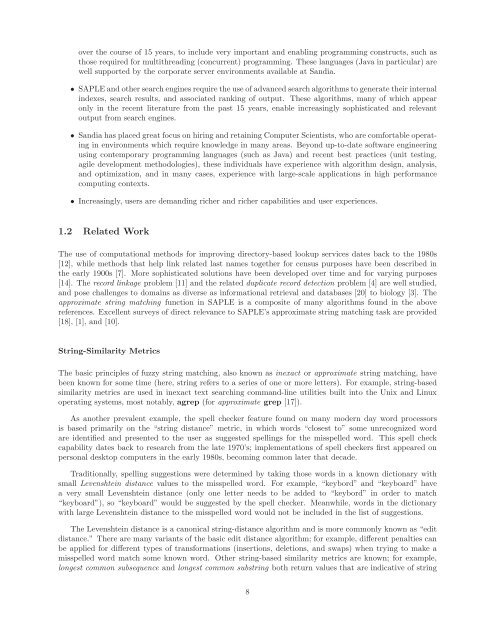SAPLE: Sandia Advanced Personnel Locator Engine - Mike Procopio
SAPLE: Sandia Advanced Personnel Locator Engine - Mike Procopio
SAPLE: Sandia Advanced Personnel Locator Engine - Mike Procopio
Create successful ePaper yourself
Turn your PDF publications into a flip-book with our unique Google optimized e-Paper software.
over the course of 15 years, to include very important and enabling programming constructs, such as<br />
those required for multithreading (concurrent) programming. These languages (Java in particular) are<br />
well supported by the corporate server environments available at <strong>Sandia</strong>.<br />
• <strong>SAPLE</strong>andothersearchenginesrequiretheuseofadvancedsearchalgorithmstogeneratetheirinternal<br />
indexes, search results, and associated ranking of output. These algorithms, many of which appear<br />
only in the recent literature from the past 15 years, enable increasingly sophisticated and relevant<br />
output from search engines.<br />
• <strong>Sandia</strong>has placedgreatfocus on hiringand retainingComputer Scientists, whoarecomfortableoperating<br />
in environments which require knowledge in many areas. Beyond up-to-date software engineering<br />
using contemporary programming languages (such as Java) and recent best practices (unit testing,<br />
agile development methodologies), these individuals have experience with algorithm design, analysis,<br />
and optimization, and in many cases, experience with large-scale applications in high performance<br />
computing contexts.<br />
• Increasingly, users are demanding richer and richer capabilities and user experiences.<br />
1.2 Related Work<br />
The use of computational methods for improving directory-based lookup services dates back to the 1980s<br />
[12], while methods that help link related last names together for census purposes have been described in<br />
the early 1900s [7]. More sophisticated solutions have been developed over time and for varying purposes<br />
[14]. The record linkage problem [11] and the related duplicate record detection problem [4] are well studied,<br />
and pose challenges to domains as diverse as informational retrieval and databases [20] to biology [3]. The<br />
approximate string matching function in <strong>SAPLE</strong> is a composite of many algorithms found in the above<br />
references. Excellent surveys of direct relevance to <strong>SAPLE</strong>’s approximate string matching task are provided<br />
[18], [1], and [10].<br />
String-Similarity Metrics<br />
The basic principles of fuzzy string matching, also known as inexact or approximate string matching, have<br />
been known for some time (here, string refers to a series of one or more letters). For example, string-based<br />
similarity metrics are used in inexact text searching command-line utilities built into the Unix and Linux<br />
operating systems, most notably, agrep (for approximate grep [17]).<br />
As another prevalent example, the spell checker feature found on many modern day word processors<br />
is based primarily on the “string distance” metric, in which words “closest to” some unrecognized word<br />
are identified and presented to the user as suggested spellings for the misspelled word. This spell check<br />
capability dates back to research from the late 1970’s; implementations of spell checkers first appeared on<br />
personal desktop computers in the early 1980s, becoming common later that decade.<br />
Traditionally, spelling suggestions were determined by taking those words in a known dictionary with<br />
small Levenshtein distance values to the misspelled word. For example, “keybord” and “keyboard” have<br />
a very small Levenshtein distance (only one letter needs to be added to “keybord” in order to match<br />
“keyboard”), so “keyboard” would be suggested by the spell checker. Meanwhile, words in the dictionary<br />
with large Levenshtein distance to the misspelled word would not be included in the list of suggestions.<br />
The Levenshtein distance is a canonical string-distance algorithm and is more commonly known as “edit<br />
distance.” There are many variants of the basic edit distance algorithm; for example, different penalties can<br />
be applied for different types of transformations (insertions, deletions, and swaps) when trying to make a<br />
misspelled word match some known word. Other string-based similarity metrics are known; for example,<br />
longest common subsequence and longest common substring both return values that are indicative of string<br />
8
















